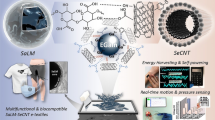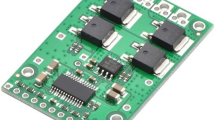Abstract
For 3D-printing circuits, highly electrical conductive composite filaments were prepared through thin-film transition technique and hot extrusion-drawing. In the filaments, flaky silver powders with nanoscale thickness and smooth flat surface were used as electrical conductive phase, and thermoplastic polyvinyl butyral was used as binder phase. The thermal properties of the electrical conductive composites were studied by thermogravimetric analysis, X-ray diffraction, and Fourier transform infrared spectrophotometric. Results showed that the electrical conductive composites possessed highly thermal stability up to 350 °C. Moreover, the scanning electron microscopy revealed that thin-film transition technique made the flaky silver powders in the cured conductive films present a face-to-face contact pattern and the well-ordered orientation remain in the composite filaments, which could greatly decrease the volume resistivity of composite filaments. The as-prepared composite filaments showed a low volume resistivity of 7.02 × 10−4 Ω cm at only 55 wt% (11.08 vol%) of flaky silver powder filling rate. The solvent-free 3D printing used composite filaments show low volume resistivity and well mechanical properties that prove the potential application in 3D-printing circuits.












Similar content being viewed by others

References
Rim YS, Bae SH, Chen H, Marco ND, Yang Y (2016) Recent progress in materials and devices toward printable and flexible sensors. Adv Mater 28:4415–4440
Zhu M, Huang Y, Huang Y, Li H, Wang Z, Pei Z et al (2017) A highly durable, transferable, and substrate-versatile high-performance all-polymer micro-supercapacitor with plug-and-play function. Adv Mater 29:1605137
Tam SK, Fung KY, Ng KM (2017) High copper loading metal organic decomposition paste for printed electronics. J Mater Sci 52:5617–5625. https://doi.org/10.1007/s10853-017-0796-0
Kölpin N, Wegener M, Teuber E, Polster S, Frey L, Roosen A (2013) Conceptional design of nano-particulate ITO inks for inkjet printing of electron devices. J Mater Sci 48:1623–1631. https://doi.org/10.1007/s10853-012-6919-8
Mohammed MG, Kramer R (2017) All-printed flexible and stretchable electronics. Adv Mater 29:1604965
Kwok SW, Goh KHH, Tan ZD, Tan STM, Tjiu WW, Soh JY et al (2017) Electrically conductive filament for 3D-printed circuits and sensors. Appl Mater Today 9:167–175
Kennedy ZC, Christ JF, Evans KA, Arey BW, Sweet LE, Warner MG et al (2017) 3D-printed poly(vinylidene fluoride)/carbon nanotube composites as a tunable, low-cost chemical vapour sensing platform. Nanoscale 9:5458–5466
Zhang D, Chi B, Li B, Gao Z, Du Y, Guo J et al (2016) Fabrication of highly conductive graphene flexible circuits by 3D printing. Synth Met 217:79–86
Leigh SJ, Bradley RJ, Purssell CP, Billson DR, Hutchins DA (2012) A simple, low-cost conductive composite material for 3D printing of electronic sensors. PLoS ONE 7:e49365
Zhang H, Zou G, Liu L, Tong H, Li Y, Bai H et al (2017) Synthesis of silver nanoparticles using large-area arc discharge and its application in electronic packaging. J Mater Sci 52:3375–3387. https://doi.org/10.1007/s10853-016-0626-9
Jiu J, Zhang H, Nagao S, Sugahara T, Kagami N, Suzuki Y (2016) Die-attaching silver paste based on a novel solvent for high-power semiconductor devices. J Mater Sci 51:3422–3430. https://doi.org/10.1007/s10853-015-9659-8
Faddoul R, Reverdy-Bruas N, Bourel J (2012) Silver content effect on rheological and electrical properties of silver pastes. J Mater Sci: Mater Electron 23:1415–1426
Park BG, Jung KH, Jung SB (2017) Fabrication of the hybrid Ag paste combined by Ag nanoparticle and micro Ag flake and its flexibility. J Alloy Compd 699:1186–1191
Wang J, Chen Z, Hu Y, Jiang X, Chen D, Zhang W (2013) Flaky silver powders prepared with nanofilm transition method: application for printable electronics. J Mater Chem C 1:230–233
Shen Y, Chen Z, Zhou T, Feng W, Liu Y (2016) Green preparation of flaky silver powders with nano-thickness towards electrically conductive adhesives through a nanofilm transition method. J Mater Chem C 4:254–258
McKeen LW (2016) 5-pigments, fillers, and extenders, 2nd edn. Elsevier, Waltham
Kirchner E (2009) Film shrinkage and flake orientation. Prog Org Coat 65:333–336
Tadjarodi A, Zabihi F (2013) Thermal conductivity studies of novel nanofluids based on metallic silver decorated mesoporous silica nanoparticles. Mater Res Bull 48:4150–4156
Tan M, Wang X, Hao Y, Deng Y (2017) Novel Ag nanowire array with high electrical conductivity and fast heat transfer behavior as the electrode for film devices. J Alloy Compd 701:49–54
Asiri AM, Hussein MA, Abu-Zied BM, Hermas AEA (2013) Effect of NiLaxFe2−xO4 nanoparticles on the thermal and coating properties of epoxy resin composites. Compos Part B Eng 51:11–18
He X, Chen Y, Wang S, He W, Wang C, Zhang H et al (2018) Enhancing inductance of spiral copper inductor with BaFe12O19/poly (phenylene oxide) composite as an embedded magnetic core. Compos Part B Eng 138:232–242
Goyal RK, Katkade SS, Mule DM (2013) Dielectric, mechanical and thermal properties of polymer/BaTiO3 composites for embedded capacitor. Compos Part B Eng 44:128–132
Roy AS, Gupta S, Seethamraju S, Madras G, Ramamurthy PC (2014) Impedance spectroscopy of novel hybrid composite films of polyvinylbutyral (PVB)/functionalized mesoporous silica. Compos Part B Eng 58:134–139
Corroyer E, Brochier-Salon MC, Chaussy D, Wery S, Belgacem MN (2013) Characterization of commercial polyvinylbutyrals. Int J Polym Anal Charact 18:346–357
Jiang Y, Xu Z, Huang T, Liu Y, Guo F, Xi J et al (2018) Direct 3D printing of ultralight graphene oxide aerogel microlattices. Adv Funct Mater 28:1707024
Krishnamoorti R, Ren J, Silva AS (2001) Shear response of layered silicate nanocomposites. J Chem Phys 114:4968–4973
He S, Zhang J, Xiao X, Hong X, Lai Y (2017) Investigation of the conductive network formation of polypropylene/graphene nanoplatelets composites for different platelet sizes. J Mater Sci 52:13103–13119. https://doi.org/10.1007/s10853-017-1413-y
Amoli BM, Hu A, Zhou NY, Zhao B (2015) Recent progresses on hybrid micro–nano filler systems for electrically conductive adhesives (ECAs) applications. J Mater Sci: Mater Electron 26:4730–4745
Taherian R (2016) Experimental and analytical model for the electrical conductivity of polymer-based nanocomposites. Compos Sci Technol 123:17–31
Zhai L, Li G, Xu Y, Xiao M, Wang S, Meng Y (2015) Poly(propylene carbonate)/aluminum flake composite films with enhanced gas barrier properties. J Appl Polym Sci 132:41663
An FZ, Wang ZW, Hu J, Gao XQ, Shen KZ, Deng C (2014) Morphology control technologies of polymeric materials during processing. Macromol Mater Eng 299:400–423
Tobjörk D, Österbacka R (2011) Paper electronics. Adv Mater 23:1935–1961
Acknowledgements
This work was supported by the Foundation of the Key Laboratory of Low-Carbon Chemistry and Energy Conservation of Guangdong Province, the Fundamental Research Funds for the Central Universities (No. 17lgpy69), and the Guangxi Natural Science Foundation (No. 2016GXNSFDA380024).
Author information
Authors and Affiliations
Corresponding author
Electronic supplementary material
Below is the link to the electronic supplementary material.
Rights and permissions
About this article
Cite this article
Lei, Z., Chen, Z., Peng, H. et al. Fabrication of highly electrical conductive composite filaments for 3D-printing circuits. J Mater Sci 53, 14495–14505 (2018). https://doi.org/10.1007/s10853-018-2645-1
Received:
Accepted:
Published:
Issue Date:
DOI: https://doi.org/10.1007/s10853-018-2645-1



